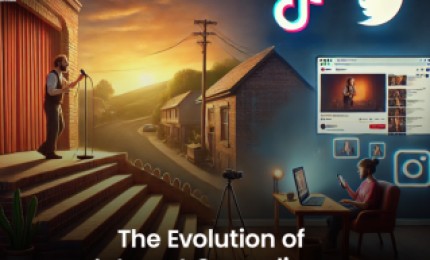In the world of events, whether it's a grand corporate gathering, a lively music concert, or an intimate wedding reception, the role of an anchor is pivotal. An anchor is not just a presenter; they are the maestros of engagement, setting the mood, and delighting the audience. The ability to connect with the audience and keep them captivated is a true art. In this article, we will explore the techniques and tips that professional anchors employ to create memorable and engaging experiences.
In the world of event anchoring, where every moment counts, the power of the first impression cannot be overstated. An anchor's role extends far beyond mere presentation; they are the architects of the audience's experience. As they step onto the stage or take the microphone, they carry the responsibility of setting the tone, establishing a connection, and captivating the audience from the very first moment.
Confidence and Warmth: Confidence is the cornerstone of a strong first impression. The anchor must exude self-assuredness, whether it's addressing a room full of corporate executives or an audience of excited music festival-goers. This confidence is contagious and sets the audience at ease, assuring them that they are in capable hands. Equally important is warmth and approachability. A genuine smile and eye contact can work wonders in breaking the initial barriers between the anchor and the audience. It's about making everyone feel welcome, acknowledged, and valued.
Acknowledging the Audience: An effective anchor doesn't just start with a scripted introduction; they begin by acknowledging the audience's presence. A simple greeting, a nod to the significance of the event, or an expression of gratitude for the attendees can make the audience feel appreciated and engaged.
Establishing Expectations:The first impression is also an opportunity to establish expectations. Depending on the nature of the event, the anchor can subtly convey what the audience can anticipate. This might involve setting a formal tone for a corporate conference or generating excitement for a music festival.
Building Anticipation: Anticipation is a powerful emotional state. Anchors can harness it by providing a tantalizing glimpse of what's to come. This could be a teaser about an exciting keynote speaker, an upcoming musical performance, or the theme of the event. Creating curiosity and anticipation early on can keep the audience engaged and eager for more. In essence, the first impression is the anchor's canvas. It's the foundation upon which the entire event is built. Whether it's through confidence, warmth, acknowledgement, or anticipation, the anchor's role in shaping this initial experience is a testament to their artistry and expertise.
The Art of Storytelling: In the world of anchoring, storytelling is the secret ingredient that transforms a mere presentation into a captivating and memorable experience. Stories have an innate ability to capture attention, evoke emotions, and convey messages in a way that facts and figures alone cannot. Anchors are the modern-day storytellers, weaving narratives that resonate with the audience and leave a lasting impact.
The Emotional Connection; At the heart of storytelling is the emotional connection. Stories have the power to make the audience feel something, whether it's joy, empathy, inspiration, or reflection. Anchors use this emotional connection to draw the audience into the narrative of the event.
Anecdotes and Examples: Anchors often use anecdotes and real-life examples to illustrate key points or themes of the event. These relatable stories make abstract concepts concrete and provide context that the audience can easily grasp. For example, in a corporate setting, an anchor might share a success story of a company's journey to inspire the audience.
Narrative Structure: A well-structured story has a beginning, middle, and end. Anchors employ this narrative structure to build anticipation, create emotional peaks and valleys, and ultimately leave a lasting impact. The beginning sets the stage and introduces the characters or elements of the story. The middle unfolds the narrative, introducing conflicts or challenges. The end offers resolution or a key takeaway.
Aligning with the Event Theme: A crucial aspect of storytelling in anchoring is alignment with the event's theme. Whether it's a product launch, a cultural celebration, or a charity fundraiser, the anchor weaves stories that resonate with the event's purpose and message. This alignment adds depth and relevance to the narrative.
Creating Memorable Moments: Great anchors understand the power of creating memorable moments through storytelling. These moments become the highlights of the event, etching themselves into the audience's memory. Whether it's a touching personal story, a humorous anecdote, or an unexpected twist in the narrative, these moments enhance the overall event experience. In essence, storytelling is the anchor's superpower. It's the tool that transforms information into inspiration and data into emotions. Through well-crafted narratives,anchors breathe life into the event, leaving the audience not just informed but deeply engaged and moved.
Adapting to the Audience:Adapting to the audience is an art that distinguishes exceptional anchors from the rest. Every event and audience is unique, and a one-size-fits-all approach simply won't suffice. Whether the event is a formal corporate conference, a festive cultural celebration, or an intimate family gathering, skilled anchors are adept at understanding the mood, preferences, and sensitivities of the audience.
Tone and Style: The anchor's tone and style should align with the nature of the event and the expectations of the audience. For a formal corporate gathering, a professional and informative tone is appropriate. In contrast, a music festival calls for energy, enthusiasm, and perhaps a touch of humor.
Sensitivity to Cultural Nuances: In our increasingly diverse world, sensitivity to cultural nuances is crucial. Anchors must be aware of cultural customs, taboos, and sensitivities to ensure that their words and actions are respectful and inclusive.
Audience Engagement Level: Understanding the audience's engagement level is key. Is the audience eager and participative, or are they reserved and observant? Skilled anchors adjust their approach to match the audience's energy, inviting participation when appropriate and respecting a more passive stance when needed.
Adapting Content: Anchors often tailor their content to suit the audience. For example, a corporate event might require in-depth industry insights and data, while a community event might focus on personal anecdotes and relatable stories.
Flexibility in Approach: Professional anchors maintain flexibility in their approach. They are open to adjusting their script, tone, or style based on the audience's response and feedback. Being adaptable is a hallmark of an anchor who truly understands their audience.
Empathy and Connection: Empathy is a fundamental trait of a successful anchor. It involves putting oneself in the shoes of the audience, understanding their emotions, needs, and expectations. Anchors who can genuinely connect with the audience create a sense of trust and rapport. In essence, adapting to the audience is a dynamic and intuitive process. Anchors who excel in this art form can read the room, adjust their performance accordingly, and create an experience that resonates deeply with the audience.
In the orchestration of an event, transitions play a pivotal role in maintaining the flow and engagement of the audience. Anchors are the conductors who ensure that these transitions are seamless, creating an uninterrupted and cohesive experience for the audience.
The Glue Between Segments: Anchors act as the glue that holds various segments of an event together. Whether it's transitioning from one speaker to another, moving from a keynote address to a panel discussion, or shifting from formal presentations to entertainment, anchors ensure that the shifts are smooth and unobtrusive.
Understanding the Event Flow: Effective transitions require a deep understanding of the event's flow. Anchors work closely with event organizers, speakers, performers, and technical teams to comprehend the sequence of activities. This knowledge helps them anticipate transition points and prepare accordingly.
Maintaining Audience Engagement: Transitions are also opportunities to maintain audience engagement. Anchors can provide brief summaries of what has happened so far, offer teasers of what's to come, or share interesting anecdotes related to the upcoming segment. This keeps the audience attentive and excited.
Contingency Planning: While meticulous preparation is essential, anchors are also skilled at contingency planning. They are prepared for unexpected situations, such as technical glitches, delays, or changes in the program. Having backup plans in place ensures that transitions remain seamless, even in challenging circumstances.
Ensuring Speaker Readiness: Part of seamless transitions involves ensuring that speakers and performers are ready for their segments. Anchors communicate with the participants, provide them with timing cues, and address any last-minute concerns or adjustments. In summary, seamless transitions are the threads that weave together the tapestry of an event. Anchors are the skilled weavers who ensure that these threads are invisible to the audience, allowing them to focus on the content and experience rather than the logistics of the event's flow.
Surprises are the spice of an event. They inject excitement, anticipation, and delight into the proceedings, leaving a lasting impression on the audience. Anchors, in collaboration with event planners, often incorporate surprises strategically to create memorable moments.
The Art of Timing: Timing is crucial when it comes to surprises. Anchors work closely with event planners to identify the most opportune moments for surprises. These moments can vary from the introduction of a surprise guest to the unveiling of a new product to a spontaneous performance.
Generating Excitement: Surprises generate excitement and intrigue. They make the audience wonder, "What's next?" This element of surprise keeps the audience engaged and attentive, as they eagerly anticipate what will happen next.
Enhancing the Event's Narrative: Surprises should enhance the event's narrative rather than disrupt it. Anchors and event planners ensure that surprises align with the event's theme, purpose, and message. This alignment adds depth and relevance to the unexpected elements.
Creating Memorable Moments: The goal of surprises is to create memorable moments that linger in the audience's memory long after the event is over. These moments become the highlights of the event, sparking conversations and leaving a positive impression.
Balancing Predictability and Surprise: While surprises are exciting, anchors understand the importance of maintaining a predictable structure. The audience should have a general idea of what to expect, and surprises should complement, not overshadow, the overall flow of the event. In conclusion, surprises are the icing on the cake of an event. When executed thoughtfully and strategically, they add an element of wonder and joy to the audience's experience. Anchors who master the art of surprises create events that are not just informative but also thoroughly enjoyable and unforgettable.
Energy and enthusiasm are the lifeblood of engaging event anchoring. Anchors are not just presenters of information; they are conductors of excitement, infusing every moment with dynamism and passion. These qualities are infectious and have the power to captivate the audience.
The Impact of Energy: Energy is palpable. It radiates from the anchor and permeates the entire event. Anchors use their physicality, movements, and vocal dynamics to convey high energy levels. Whether it's a corporate seminar or a music festival, energy is the driving force that keeps the audience engaged.
Sustaining Consistency: Sustaining high energy levels throughout an event can be demanding. Skilled anchors employ techniques to maintain consistency. They stay hydrated, practise deep breathing, and pace themselves effectively to ensure that they are as energised at the end of the event as they were at the beginning.
Setting the Mood: Energy also plays a role in setting the mood of the event. Anchors adjust their energy levels to match the desired atmosphere. For a high-energy concert, they bring boundless enthusiasm, while a reflective memorial service may call for a more subdued and respectful tone.
Emotional Connection: Energy and enthusiasm contribute to the emotional connection between the anchor and the audience. When the anchor exudes passion and excitement, the audience is more likely to respond with enthusiasm and engagement. In essence, energy and enthusiasm are the engines that drive engaging anchoring. They elevate the event from a mere presentation to a memorable experience. Anchors who can harness and channel this energy effectively become the catalysts for a dynamic and captivating event.
In the world of event anchoring, unforeseen challenges are par for the course. Technical glitches, last-minute changes, and unexpected hiccups are all part of the territory. Anchors are the calm in the storm, exhibiting grace under pressure to ensure that the event continues smoothly.
Composure in Crisis: When challenges arise, anchors remain composed. They do not let panic or frustration show, as this can create anxiety among the audience. Instead, they exhibit a sense of calm and assurance that reassures everyone that the situation is under control.
Quick Decision-Making: Anchors are adept at making quick, effective decisions. They collaborate with event organisers, technical teams, and participants to resolve issues swiftly. Whether it's a malfunctioning microphone or a sudden change in the program, anchors have contingency plans and the ability to adapt on the fly.
Problem-Solving Skills: Problem-solving is a core skill for anchors. They approach challenges with a solution-oriented mindset, seeking practical ways to address the issue while minimising disruption to the event. Effective communication with the event team is crucial to coordinate solutions.
Maintaining Professionalism: No matter the challenge, anchors maintain professionalism. They do not engage in blame or criticism but focus on finding solutions and ensuring that the event proceeds smoothly. Professionalism in the face of adversity is a mark of a seasoned anchor.
Supporting the Team: Anchors are part of a larger event team, and they play a supportive role when challenges arise. They collaborate with technical teams, stage managers, and event planners to address issues collectively. Teamwork is essential in navigating unexpected situations. In summary, grace under pressure is a hallmark of a skilled anchor. It is the ability to remain composed, make quick decisions, and solve problems effectively in the midst of challenges. Anchors who can navigate adversity with professionalism and resilience ensure that the show goes on, leaving the audience with a positive and memorable experience.
The art of engaging an audience through anchoring is a skill that is constantly evolving. Skilled anchors understand that there is always room for improvement, and they are committed to ongoing growth and enhancement of their craft.
Seeking Feedback: Anchors actively seek feedback from event organizers and attendees. This feedback provides valuable insights into what worked well and areas for improvement. Constructive criticism is embraced as an opportunity for growth.
Self-Reflection and Analysis: Self-reflection is a powerful tool for improvement. Anchors analyze their own performances, identifying strengths and weaknesses. They consider what elements of their anchoring were effective and what aspects could be refined.
Investing in Training: Professional development is a priority for anchors who aspire to excellence. They invest in training, workshops, and courses that enhance their anchoring skills. This may include voice modulation training, public speaking courses, or even acting classes to improve stage presence.
Staying Informed: Anchors stay informed about industry trends, audience preferences, and emerging technologies. This knowledge allows them to adapt to changing dynamics and deliver engaging experiences that resonate with contemporary audiences.
Experimentation and Innovation: Innovation is a driving force in anchoring. Anchors are open to experimenting with new techniques, formats, and technologies to keep their anchoring fresh and engaging. They are not afraid to push boundaries and try new approaches. In essence, continuous improvement is the compass that guides anchors toward excellence. It is the commitment to growth, the hunger for feedback, and the dedication to mastering the art of engaging an audience through anchoring. Anchors who embrace this ethos ensure that each event they anchor is better than the last, leaving the audience with an unforgettable experience.
In the dynamic realm of event anchoring, where every moment is a canvas for engagement, the journey we've embarked upon reveals the intricate artistry that defines this craft. From the moment an anchor steps onto the stage to the final applause, every element plays a crucial role in shaping the audience's experience. As we conclude our exploration, we reflect on the mastery and dedication that elevate event anchoring to an art form. The journey begins with the power of the first impression. Anchors, armed with confidence, warmth, and a welcoming demeanor, set the stage for what's to come. Their initial interactions create a sense of anticipation, making the audience eager participants in the unfolding event. This first impression is the canvas upon which the event's narrative is painted. Storytelling emerges as the anchor's brushstroke, adding depth, emotion, and relevance to the event. Through anecdotes, narratives, and relatable stories, anchors connect with the audience on an emotional level. They craft stories that not only inform but also resonate, leaving a lasting impact. Interactivity is the heartbeat of engagement. Anchors invite the audience to become active participants in the event, transforming passive spectators into engaged contributors. The use of open-ended questions, polls, quizzes, and challenges creates a dynamic dialogue, enriching the event experience. Adapting to the audience is the anchor's skillful dance. Whether the audience is formal and reserved or exuberant and expressive, skilled anchors tailor their approach to match the mood. They display empathy and sensitivity, ensuring that every member of the audience feels valued and included. Seamless transitions are the threads that bind an event together. Anchors act as the glue, ensuring that shifts between segments are smooth and unobtrusive. Their ability to maintain audience engagement during transitions is a testament to their professionalism and attention to detail.
Surprises are the bursts of color that make an event truly memorable. Anchors, in collaboration with event planners, strategically introduce unexpected elements that delight and intrigue the audience. These surprises enhance the event's narrative, creating moments that live on in the audience's memory. Energy and enthusiasm are the anchors' dynamic fuel. They infuse the event with vibrancy and passion, setting the mood and captivating the audience. Energy is a powerful contagion, and skilled anchors know how to harness it to keep the audience engaged and excited. Grace under pressure is the anchor's unwavering strength. In the face of challenges and unexpected hiccups, they remain composed and solution-oriented. Their ability to think on their feet and make quick, effective decisions ensures that the event proceeds seamlessly.
Continuous improvement is the compass that guides anchors toward excellence. They seek feedback, reflect on their performances, invest in training, stay informed, and experiment with innovation. Anchors committed to growth ensure that each event they anchor surpasses the last in quality and impact. As we conclude this journey, we recognize that event anchoring is more than a role; it's an art form. It's the fusion of charisma, storytelling, interactivity, adaptability, and professionalism. Anchors are the maestros of engagement, orchestrating experiences that inspire, inform, and entertain. Their dedication to mastery ensures that every event they anchor becomes a masterpiece of engagement, leaving the audience with an indelible impression and a desire for more. In the world of events, where memories are made and messages are conveyed, the art of engaging an audience through successful anchoring stands as a testament to the power of human connection and creativity.

15 Ways to Make Money as a Singer: A Complete Guide to Monetizing Your VoiceEarning money as a singer requires more than just talent, it demands creativity, persistence, and a willingness to explore...
Read Blog
When Kunal Kamra's Humor Got Him Into Trouble: A Deep Dive into the Controversies of India's Most Fearless ComedianKunal Kamra Controversy: Laughter, Lawsuits, and the Limits of Free SpeechStand-up...
Read Blog
The Oscar race is always full of drama, but this year? It’s absolute chaos. From shocking controversies to unexpected winners, the battle for Best Picture at the 2024 Academy Awards has taken...
Read Blog
In the ever-changing landscape of entertainment, few transformations have been as dramatic and swift as the rise of internet comedians. What began as a platform for amateur funny videos has evolved...
Read Blog
Introduction: In the competitive world of entertainment and talent, having the right representation can make all the difference in launching and sustaining a successful career. Whether you're...
Read Blog.jpg)
While the world of modelling often dazzles with glitz and glam, it's also critical we discuss its darker shades, pulling the curtain back on some challenging realities. Today, let's embark on...
Read Blog